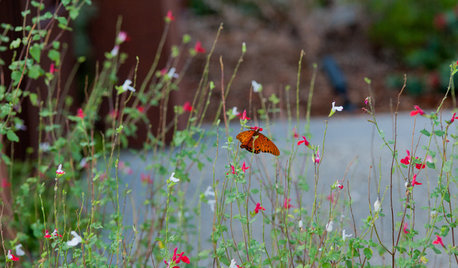looking for advice, help, guidance with butterfly habitat
15 years ago
Related Stories

FLOWERS AND PLANTSHelp Monarchs and Other Butterflies by Planting Common Milkweed
Summer-blooming Asclepias syriaca is an important larval host plant for the monarch butterfly and attracts a number of pollinating insects
Full Story
EARTH DAYCreate a Container Wildlife Habitat for Hummingbirds and Butterflies
Don’t let limited space prevent you from welcoming wildlife into your garden
Full Story
GARDENING GUIDES6 Steps to Creating Your Butterfly Garden
Encourage these fanciful winged beauties to visit your garden while helping restore their fragmented habitat
Full Story
GARDENING FOR BUTTERFLIESBring on the Birds: Natural Habitat Ideas for Gardens of All Sizes
Provide nesting, watering and perching spots inspired by the Costa Rican jungle and watch the birds flock on over
Full Story
WORKING WITH PROSWorking With Pros: When You Just Need a Little Design Guidance
Save money with a design consultation for the big picture or specific details
Full Story
CALIFORNIA NATIVE PLANTSGreat Design Plant: Asclepias Is Attractive to Monarch Butterflies
Increase monarch butterfly populations in California by planting stunning native milkweeds
Full Story
EARTH DAYHow to Help Your Town’s Beneficial Birds and Bugs
Make a habitat using local materials to provide a home to the creatures that help our gardens
Full Story
FARM YOUR YARDAdvice on Canyon Farming From L.A.'s Vegetable Whisperer
See how a screened garden house and raised beds help an edible garden in a Los Angeles canyon thrive
Full Story
GARDENING FOR BUTTERFLIESBe a Butterfly Savior — Garden for the Monarchs
Keep hope, beauty and kindness alive in the landscape by providing a refuge for these threatened enchanters
Full Story
GARDENING GUIDES6 Plants That Beat Butterfly Bush for the Wildlife Draw
It's invasive, a nonnative and a poor insect magnet. Check out these better alternatives to butterfly bush in the garden
Full Story





MissSherry
spiritwildOriginal Author
Related Professionals
Canton Landscape Architects & Landscape Designers · Wrentham Landscape Architects & Landscape Designers · Arnold Landscape Architects & Landscape Designers · Roosevelt Landscape Architects & Landscape Designers · Forest City Landscape Architects & Landscape Designers · Belvedere Park Landscape Contractors · Rockville Landscape Contractors · Columbia Fence Contractors · Dundalk Fence Contractors · Lakewood Fence Contractors · Santa Ana Fence Contractors · Fort Collins Window Contractors · Damascus Window Contractors · Goulds Window Contractors · Vista Park Window Contractorsbernergrrl
spiritwildOriginal Author
MissSherry
spiritwildOriginal Author
bernergrrl
spiritwildOriginal Author
ronkw
bernergrrl
ronkw
jrcagle